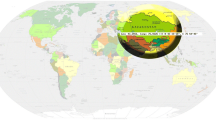Abstract
The objective of this study is to perform a safety assessment of chromafenozide residue level on tomato at the Egyptian national level. An open field decline study of chromafenozide on tomato was performed. The theoretical maximum daily intake (TMDI) of chromafenozide was calculated for assessing the chronic dietary exposure indicating that the ADI value of chromafenozide (0.27 mg/kg bw/day) was not exceeded. As a result, the safety assessment of chromafenozide residue levels was attained. A validated method of the QuEChERS approach followed by HPLC–DAD analysis was used to determine the chromafenozide residues. The recoveries ranged from 70 to 88% with relative standard deviations ranging from 2.0 to 9.0%. The limit of quantitation was 0.01 mg/kg. The half-life of chromafenozide on tomatoes was 3.5 days.



Similar content being viewed by others
References
Anastassiades, M., Scherbaum, E., Taşdelen, B., & Štajnbaher, D. (2007). Recent developments in QuEChERS methodology for pesticide multiresidue analysis. In H. Ohkawa, H. Miyagawa, & P. W. Lee (Eds.), Pesticide chemistry: crop protection, public health, environmental safety. Weinheim: Wiley-VCH Verlag GmbH & Co. KGaA. doi:10.1002/9783527611249.ch46.
CODEX (2006). Procedural manual, 15th ed. Rome, Food and Agriculture Organization of the United Nations, Joint FAO/WHO Food Standards Programme.
Ditya, P., Das, S. P., & Anjan, B. (2012). HPLC method development and validation of chromafenozide in paddy. Bulletin of Environmental Contamination and Toxicology, 89, 1277–1283.
EU (2015). EU Pesticides database. http://ec.europa.eu/food/plant/pesticides/eu-pesticides-database/public/?event=activesubstance.detail&language=EN&selectedID=1140
FAO/WHO (1999). Recommended methods of sampling for the determination of pesticide residues for compliance with MRLs. http://www.fao.org/fao-who-codexalimentarius/standards/list-of-standards/en/
Malhat, F., Badawy, M. A. H., Barakat, A. D., & Saber, N. A. (2014). Residues, dissipation and safety evaluation of chromafenozide in strawberry under open field conditions. Food Chemistry, 152, 18–22.
Moye, H. A., Malagodi, M. H., Yoh, J., & Wislocki, P. G. (1987). Residues of avermectin B1a in rotational crops and soils following soil treatment with [14C] avermectin B1a. Journal of Agricultural and Food Chemistry, 35, 859–864.
SANCO (2013). Guidance document on analytical quality control and validation procedures for pesticide residues analysis in food and feed. http://www.eurl-pesticides.eu/library/docs/allcrl/AqcGuidance_Sanco_2013_12571.pdf
Tomlin, C. (2004). The pesticide manual (13th ed.). Surrey: British Crop Protection Council.
WHO. (1995). Application of risk analysis to food standard issues. Report of a FAO/WHO consultation. Geneva: World Health Organization http://www.fao.org/docrep/008/ae922e/ae922e00.htm.
WHO. (2013). GEMS/Food consumption database. https://extranet.who.int/sree/Reports?op=vs&path=/WHO_HQ_Reports/G7/PROD/EXT/GEMS_cluster_diets_2012&userid=G7_ro&password=inetsoft123
WHO/FAO (2005) Dietary exposure assessment of chemicals in food. http://apps.who.int/iris/bitstream/10665/44027/1/9789241597470_eng.pdf
Winter, C. K., & Francis, F. J. (1997). Assessing, managing and communicating chemical food risk. Food Technology, 51(5), 85–92.
Zhao, M., Yu, A., Zhu, Y., Wu, S., & Kim, J. (2016). Human exposure and risk assessment of chromafenozide during treatment in rice fields. Human and Ecological Risk Assessment, 22(1), 116–125.
Acknowledgments
The authors thank for the support from Central Agricultural Pesticides Laboratory (CAPL), Agriculture Research Center (ARC), Cairo, Egypt. The authors thank the support from Michigan State University, East Lansing, Michigan, USA.
Author information
Authors and Affiliations
Corresponding author
Rights and permissions
About this article
Cite this article
Abdelraheem, E., Arief, M., Mohammad, S.G. et al. Safety assessment of chromafenozide residue level with decline study on tomato in Egypt. Environ Monit Assess 189, 180 (2017). https://doi.org/10.1007/s10661-017-5894-6
Received:
Accepted:
Published:
DOI: https://doi.org/10.1007/s10661-017-5894-6




